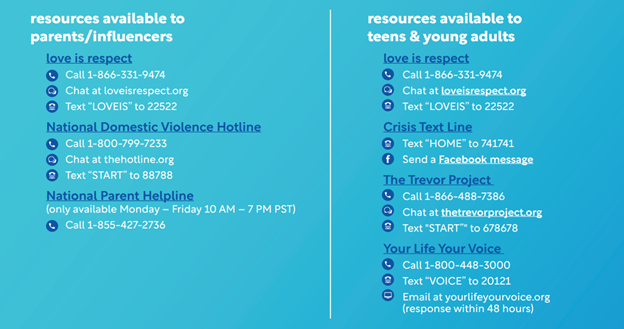La violencia en las citas entre adolescentes (TDV) se define como "un patrón de abuso o amenaza de abuso contra parejas adolescentes." La violencia en las citas entre adolescentes se produce con una prevalencia aleccionadora, afectando a 1,5 millones de estudiantes de secundaria cada año. Las mujeres y los estudiantes LGBTQ+ son más propensos a sufrir abuso y/o violencia en el noviazgo que sus compañeros varones cisgénero. La violencia en el noviazgo se considera una experiencia adversa de la infancia, por lo que afecta a la salud mental, emocional y física de una persona a lo largo de toda su vida. Al igual que otros factores de riesgo de experiencias infantiles adversas, las minorías raciales, étnicas y de bajos ingresos, junto con otras comunidades marginadas, tienen más probabilidades de sufrir TDV en tasas más altas. Los adolescentes que han sufrido violencia en el noviazgo tienen más probabilidades de sufrir depresión, ansiedad, ideación suicida y adoptar comportamientos de alto riesgo o poco saludables.
A pesar de lo común que es sufrir algún tipo de maltrato por parte de la pareja, 48% de los adolescentes y jóvenes adultos admiten no haber hablado nunca con nadie sobre su experiencia, y 57% esperan más de 6 meses para buscar ayuda.
Febrero es el Mes Nacional de Concienciación sobre la Violencia en el Noviazgo de Adolescentes (TDVAM). El mes del "amor" es un mes apropiado para empoderar a los jóvenes a través de oportunidades de educación y compromiso; enseñándoles que "lo sano no hace daño" y que la violencia y la falta de respeto no existen en las relaciones amorosas y respetuosas. Los CDC, la FVPSA, Futures Without Violence y la National Domestic Hotline son solo algunas de las organizaciones que trabajan para ayudar a los jóvenes a entender cómo es el maltrato en las citas, los elementos clave para tener relaciones sanas y cómo obtener ayuda.
Tipos de maltrato en las relaciones de pareja
Physical: golpes, mordiscos, bofetadas, empujones, puñetazos en las paredes, tirones de pelo, quemaduras.
Sexualtocamientos o contactos sexuales no consentidos, comportamiento sexual no físico como compartir imágenes sexuales o información sobre alguien sin su consentimiento, o sexting y sextorsión o chantaje no consentidos.
Psicológico/Emocional/Social: comunicación verbal o no verbal, control de las actividades de la pareja, aislamiento, insultos, amenazas, culpas, exigencias, tratamiento fantasma o silencioso, mentiras, gaslighting, burlas, comentarios degradantes o negativos, etc.
AcosoPatrón repetido de atención o contacto no deseados que causa a alguien malestar, miedo y sentimientos de inseguridad.
Señales de advertencia
Celos excesivos, comportamiento o humor volátil, presionar o no respetar los límites, comportamientos culpabilizadores, controlar los movimientos o la actividad social, comportamientos intimidatorios o amenazantes, falsas acusaciones, son signos potenciales de advertencia de maltrato en el noviazgo adolescente.
Posibles signos o síntomas de TDV
Lesiones, contacto excesivo como mensajes de texto o en persona con el agresor, disminución de las calificaciones y del interés por actividades o personas queridas, miedo a discrepar con la pareja, etc.
¿Ayuda para padres y familias?
Los datos muestran que los padres no entienden la prevalencia de la violencia en las citas entre adolescentes y no son capaces de reconocer los signos de abuso en sus propios hijos. Una falsa sensación de confianza les hace juzgar mal lo que su hijo sabe sobre los riesgos y las señales de advertencia de la violencia en las citas entre adolescentes o les lleva a pensar que su hijo es demasiado joven o no está en riesgo. Además, los padres a menudo saben aún menos sobre el abuso que su hijo puede experimentar en los espacios en línea o en las redes sociales. (78% de los abusos y acosos en línea se producen a través de aplicaciones de texto o mensajería). ¿Qué ayuda hay para los padres? Muchas ayudas implican que los padres mantengan conversaciones sinceras y abiertas con sus hijos sobre cómo son y cómo se sienten las relaciones sanas. La siguiente guía explica a los padres qué es el maltrato en las citas entre adolescentes, cómo hablar y apoyar a un hijo antes o durante las citas, y cómo apoyar a ese hijo que puede ser el causante del daño a otro. Guía para padres 2021 (loveisrespect.org)
Ayuda para adolescentes y jóvenes adultos
La educación y la capacitación pueden reducir la violencia física y sexual en las citas en 60%. Las intervenciones escolares pueden reducir en gran medida la violencia en las citas entre adolescentes, concretamente los abusos físicos y sexuales, hasta en 54%. El informe de los CDC "Cuestiones de citas" y el proyecto de la National Domestic Violence Hotline "El amor es respeto"Ambos ofrecen estrategias para fomentar relaciones sanas entre los adolescentes mediante una programación integral y el acceso a los conocimientos y apoyos que necesitan. "El amor es respeto" es un proyecto que trabaja para magnificar las voces de los jóvenes, en concreto. El tema de este año "Atrévete"fue creado por el Consejo de la Juventud del proyecto para poner de relieve cómo la educación, junto con la participación de la comunidad y la familia, puede capacitar a los jóvenes para buscar y establecer relaciones que reflejen comportamientos y límites saludables. A continuación se ofrecen dos amplios recursos para adolescentes y sus familias.
2211-TDVAM-Action-Guide_FINAL.pdf (loveisrespect.org)
El noviazgo importa: Estrategias para promover relaciones sanas entre los adolescentes (cdc.gov)
Líneas directas (El amor es respeto(Guía para los padres, 2021) Se ofrece apoyo 24 horas al día, 7 días a la semana, a quienes busquen ayuda.

Recursos
Prevención de la violencia entre adolescentes (cdc.gov)
Violencia entre adolescentes: La epidemia (vawnet.org)
The Facts on Tweens and Teens and Dating Violence.pdf (futureswithoutviolence.org) (en inglés)
Concienciación sobre la violencia entre parejas adolescentes (teendvmonth.org)
 Escrito por Helen Baker - Educadora sanitaria
Escrito por Helen Baker - Educadora sanitaria
